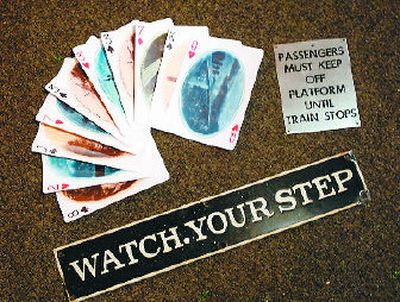Climb aboard

It’s “all aboard” for a nostalgic trip on Tuesday, when the Museum of North Idaho opens for the 2007 season with its new lobby exhibit, “Ties to the Past: Railroad History in the Coeur d’Alene Region.”
The exhibit explores the local development of railroads, their economic impact, the demise of the original railways and our continuing fascination with trains, according to museum director Dorothy Dahlgren.
“The railroads were vital to the development of this region,” she says.
Until 1883, when the Northern Pacific arrived, the Idaho Panhandle was slow to develop. Then, other national railroad corporations rolled onto the scene, all eager to share in the riches generated by Idaho’s Silver Valley mining district, the region’s vast timberlands and the potential for passenger service to serve a growing population.
After 1883, events moved swiftly. In 1887, the federal government bought land for a right of way from the Coeur d’Alene Tribe of Indians. The new line, as surveyed, followed rivers and lakes and ran in a northeasterly direction from the western Idaho border to Mullan on the east and provided direct access to the Silver Valley mines. Union Pacific eventually bought out the Oregon Railway and Navigation Co., which had surveyed the route and laid the rails.
In 1892, the Great Northern established its presence in the region when it bought out the financially troubled Spokane/Coeur d’Alene Electric Line, which had provided service to Coeur d’Alene, Hayden Lake, Liberty Lake and the Palouse wheat country.
The story of the rise and fall of the Electric Line and its powerful role in the development of the Coeur d’Alene area is a colorful tale that involved many of the region’s early movers and shakers.
The last major rail company to enter the region was the Milwaukee Road, which extended its operations from Chicago to the Puget Sound region between 1905 and 1910.
This year’s museum exhibit was planned to coincide with release of Stan Johnson’s “The Milwaukee Road’s Western Extension: The Building of a Transcontinental Railroad.” It is Johnson’s third book to be published by the museum.
His two previous books were “The Milwaukee Road Olympian” and “Milwaukee Road in Idaho.”
Dahlgren says the new volume is a well-researched “saga of great accomplishment and remarkable people.”
A large regional map clearly showing the various railroad lines will introduce visitors to the scope of the museum display. As visitors walk through the exhibits, they will be able to follow the history and rise and fall of each major rail line. Photographs accompany the text that explains the history and significance of those railroads.
A special feature should appeal to the kid in everyone. Set designer and artist Justin Eaton has designed and built a cab of a steam engine. The cab is built nearly to actual scale and fills a corner of the lobby.
The Historical Railroad Society of the Inland Empire has contributed many artifacts from its extensive collection, including large brown crockery insulators once used on the Milwaukee’s electrified sections of track. The Milwaukee ran on steam and electrical power, the latter primarily being used in mountainous sections of Western Montana and the Idaho Panhandle and through the Washington Cascades.
There also is an upholstered seat that once cushioned the ride from Spokane to Coeur d’Alene for Electric Line passengers.
Volunteer Karen DeSeve introduced a touch of reality in this display by placing a wooden window beside the seat. The window frames a color photo of a barn and green hills, creating the feeling that the viewer is looking out a train window at the passing landscape.
Railroaders from the society also brought along a four-man handcar. Since the handcar had no engine, four men were needed to pump it and send it speeding along the rails.
Railroad society members also contributed work tools and implements used to build the railroads and keep them running. Included are railroad lanterns, one with rare red glass, and schedules, tickets and even some dishes rescued from the gravel. The dishes, such as a pink sauce dish with a flying goose in the center, were used on dining cars and still are perfect after years of lying in the dirt.
What would a railroad display be without a bell? The railroad society has provided a brass bell that once hung on the nose of a Northern Pacific steam locomotive.
Toy trains and model trains also are displayed. Roy Tillotson has loaned his own handcrafted “S” gauge locomotive and tender, and Ted Holloway added his Lionel toy train collection. Visitors also will be able to see Marvin Lake’s unit, which he created from bits and pieces he picked up along the Milwaukee right of way.
Dahlgren says that the many hours contributed by museum volunteers and members of the railroad society are responsible for making the show a success.
The first free day will be April 7, when the museum will be open to the public without charge. It’s an opportunity for families to learn about the Indians, the early settlers, steamboats and fire lookouts that make up the history of the Inland Northwest.